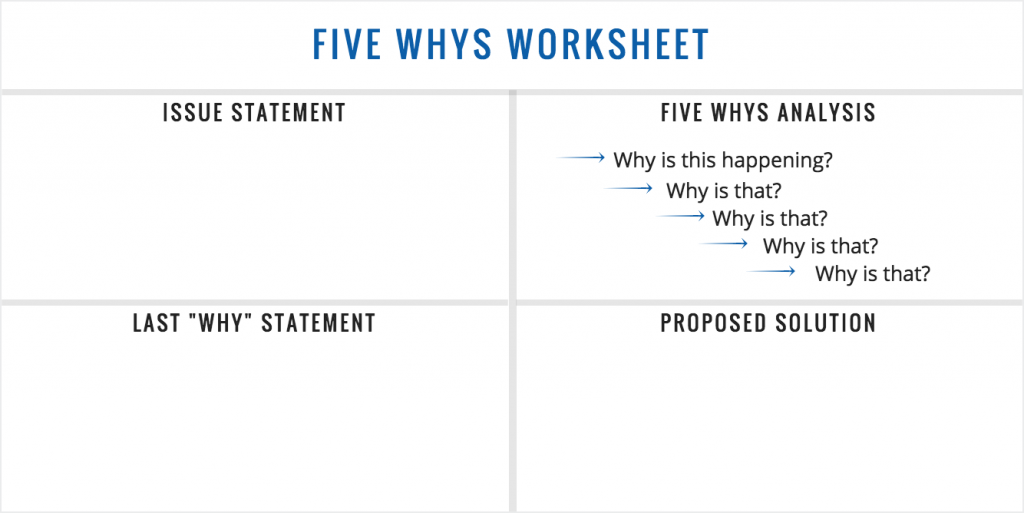IT Consulting, Training & Staffing Resource Hub

February 5, 2018 | BRM
What are the telltale signs of strained business relationships? Your business partner is dissatisfied. You begin observing behaviours such as finger-pointing, defensiveness, even passive-aggressive behaviour in your organisation. Furthermore, your business partners no longer include you in strategic discussions.How did this happen? What methods can you use to get to the root cause of the situation? One thing is certain: if you don’t ask the right questions, you won’t get the right answers. To get to the bottom of things, the best method is to ask follow-up questions—five times. When business relationships breakdown, most of the time the underlying reason lies in misaligned organisational objectives, which result in misaligned organisational priorities. This prevents the delivery of value to your strategic partners, business partners, and stakeholders. However, determining the exact misalignment of priorities is often difficult; varied and numerous symptoms prevent an easy diagnosis.
A Diagnostic Technique For Strained Business Relationships
To effectively diagnose the root cause of the business relationships breakdown, the ‘Five Whys’ is a simple question-asking technique that explores the causes and effects underlying the problem. This technique was developed by Sakichi Toyoda for the Toyota Industries Corporation and is currently used within Kaizen, lean manufacturing, and Six Sigma as a best practice. Effective use of the ‘Five Whys’ technique requires an accurate and complete statement of the issue, determination to get to its foundation, and honesty in answering the questions and shaping the solution. By asking “Why?” five times, we aim to peel away the layers of symptoms that hide the cause of strained business relationships, then propose a solution based on the last “why.”

Example Of A ‘Five Whys’ Analysis
A business organisation received some very negative feedback on a recent business partner satisfaction survey.1) According to the survey, business partners are unsatisfied. Why? An important end-user business application delivered functions with serious quality defects: it was slow in transaction speed, froze regularly, wasn’t integrated with existing ERP, and forced users to execute a number of steps manually. Therefore: 2) Business outcomes are clearly jeopardized, but the IT department did not do anything to address those issues. Why? The application has serious quality issues which cannot be resolved in the short term. IT raised the risk of there being quality issues prior to the release date, but they were ignored. And therefore: 3) The schedule for the integration phase of the project was severely compressed at the request of the business owner. Why? They insisted on delivery by the end of the fiscal year. And therefore: 4) IT quality gates were cut. IT objected to such a fast delivery, but was overruled. Why? The business leaders’ objective was to deliver the application by the end of the year to demonstrate its value to stakeholders. IT knew about the risks of cutting the quality gates, but failed to manage the expectations of the business stakeholders. And therefore: 5) IT and the business leaders had conflicting priorities. Why? The business leaders’ priority was speed, for which they were willing to sacrifice quality. They failed to realise the potential consequences that system malfunctions might have. IT, in turn, did not manage business leaders’ expectations properly.In the end, organisation stakeholders forgot about the source of the issue, accusing IT of incompetence. IT, on the other hand, charged their business counterparts with having unreasonable expectations and putting undue pressure on them. The blame game has begun.
The Solution
- Sit down with business partners and align organizational values via open, value-driven dialogue.
- Agree on guiding principles and a vision.Define how value will be managed and measured.
- Build a value plan.
- Based on the value plan, re-align organizational priorities and communicate.
How To Start
The best way to approach the ‘Five Whys’ analysis is through facilitated workshops with key stakeholders—the presence and support of management during this exercise is a key factor in your future success.Keep asking the question “Why?” until the root cause is determined, the elimination of which will prevent the error from occurring again.
Do’s And Dont’s
Do:
- Formulate your answers from the business partner’s point of view.
- Put effort into distinguishing causes from symptoms, basing your distinctions on facts and knowledge—not assumptions.
- Finish statements created through the ‘Five Whys’ analysis with the expression “and therefore” to indicate a transition in your chain of reasoning.
- Make your analysis visual: write everything down and make it visible to all participants.
Don’t:
- Jump to conclusions.
- Assess people. Instead, assess the processes and events.
- Simply cite “human error.”
Things To Watch Out For
- Be careful not to mistake symptoms for root causes.
- Make sure you have all the information required. Lack of information limits your ability to analyze beyond your current knowledge base.
- Remove organizational culture barriers; lack of organizational support can prevent analysts from asking the right questions.
- There is always the risk of investigating only one branch of an issue, while the real issue might have several underlying causes. In this case, several ‘Five Whys’ analyses should be undertaken.
Always take a deliberate approach when fixing strained business relationships that have broken down,. By breaking the problem down into pieces and revealing its root cause, the ‘Five Whys’ analysis gives you simple and straightforward guidelines to handle even the most complicated problems you or your organization might be facing.
Share this post
Share on facebook
Share on google
Share on twitter
Share on linkedin
Share on pinterest
Share on print
Share on email
